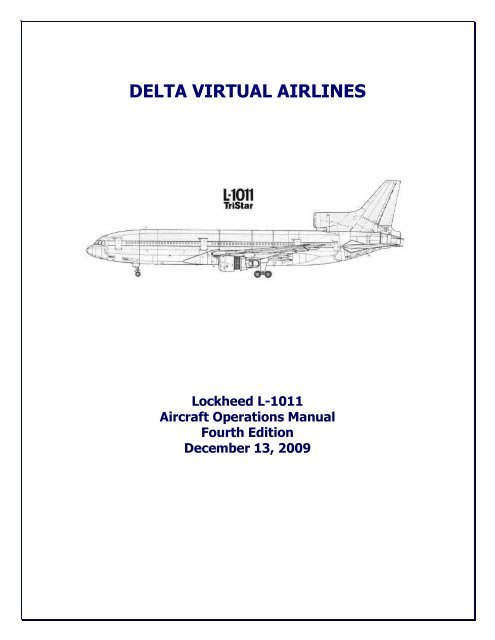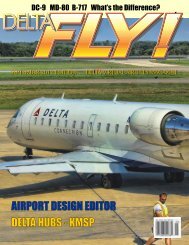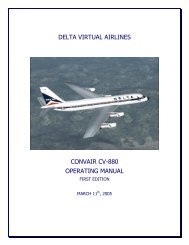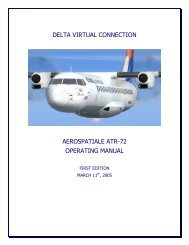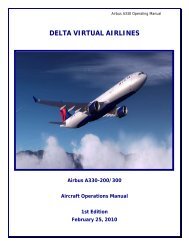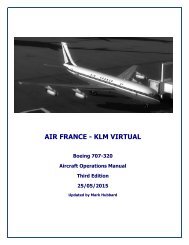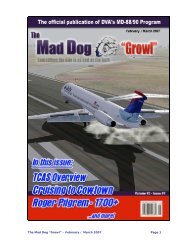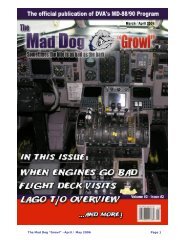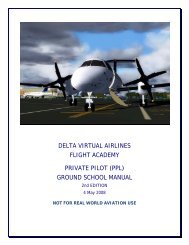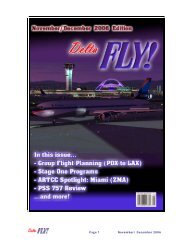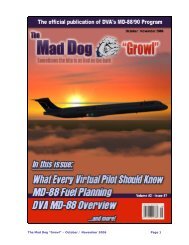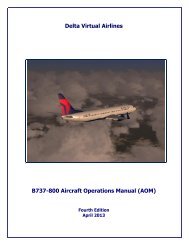Lockheed L-1011-100 - Delta Virtual Airlines
Lockheed L-1011-100 - Delta Virtual Airlines
Lockheed L-1011-100 - Delta Virtual Airlines
Create successful ePaper yourself
Turn your PDF publications into a flip-book with our unique Google optimized e-Paper software.
DELTA VIRTUAL AIRLINES<br />
<strong>Lockheed</strong> L-<strong>1011</strong><br />
Aircraft Operations Manual<br />
Fourth Edition<br />
December 13, 2009
Table of Contents<br />
i<br />
<strong>Lockheed</strong> L-<strong>1011</strong> Operating Manual<br />
Welcome ........................................................................................................1<br />
History and Overview ......................................................................................2<br />
Specifications – L-<strong>1011</strong>-<strong>100</strong> .............................................................................7<br />
Specifications – L-<strong>1011</strong>-500 .............................................................................8<br />
Cockpit Checkout ............................................................................................9<br />
Flying the LOCKHEED L-<strong>1011</strong>-<strong>100</strong> - Tutorial....................................................13<br />
Fuel Planning and Weight and Balance ...........................................................17<br />
<strong>Lockheed</strong> L-<strong>1011</strong> Checklist ............................................................................20<br />
Gate Departure..........................................................................................20<br />
Engine Start ..............................................................................................21<br />
After Engine Start......................................................................................21<br />
Taxi To Active ...........................................................................................21<br />
Before Takeoff...........................................................................................22<br />
Takeoff - Cleared or Taxi into position & hold..............................................22<br />
Climb to Altitude........................................................................................23<br />
Cruise .......................................................................................................23<br />
Descent ....................................................................................................23<br />
Approach ..................................................................................................23<br />
Landing.....................................................................................................24<br />
After Landing (When clear of the runway)...................................................24<br />
Shutdown .................................................................................................24<br />
Crew Take-Off Briefing...............................................................................25<br />
Crew Announcements ................................................................................26<br />
Appendix A – Typical Configuration ................................................................27<br />
Appendix B—Takeoff Speeds .........................................................................28<br />
Appendix C —Speed Template .......................................................................29<br />
Appendix D —Standard Information ...............................................................31<br />
Appendix E —Approach and Landing Speeds ..................................................33<br />
Acknowledgements and Legal Stuff................................................................35
Welcome<br />
1<br />
<strong>Lockheed</strong> L-<strong>1011</strong> Operating Manual<br />
Welcome to the <strong>Delta</strong> <strong>Virtual</strong> <strong>Airlines</strong> Aircraft Operating Manual (AOM) for the<br />
<strong>Lockheed</strong> L-<strong>1011</strong>.<br />
The AOM is based upon the DVA Fleet Installer. We are always seeking to<br />
improve the accuracy of the AOM.<br />
Should you have questions about the specifics of this airplane or this manual,<br />
you should create a Help Desk issue at our website, www.deltava.org<br />
Should you have questions about aviation in general, creating a Help Desk issue<br />
is the best course of action to take. The training department and the flight<br />
academy personnel, who will do their best to answer your questions, will address<br />
these.<br />
If you are new to flying and would like to learn, we offer training that is modeled<br />
after real world training. Sign up for flight instruction in the DVA Flight<br />
Academy.
History and Overview<br />
2<br />
<strong>Lockheed</strong> L-<strong>1011</strong> Operating Manual<br />
In the late 1960’s, the airline industry wanted a bigger aircraft for Coast-to-Coast<br />
service in the USA. A request from American <strong>Airlines</strong> for an aircraft in a 250passenger<br />
version gave birth to a new project for the civilian market. The aircraft<br />
should have sufficient range to fly routes like Chicago to Los Angeles nonstop.<br />
Soon it became evident that both McDonnell Douglas and <strong>Lockheed</strong> were<br />
working on very similar prototypes. The competition between the two would be<br />
very sharp! Earlier, Boeing launched the Boeing 747 jumbo-jet and this giant<br />
aircraft became an immediate sales success.<br />
Both <strong>Lockheed</strong> and McDonnell Douglas wanted to see their aircraft in the air first<br />
and McDonnell Douglas won that battle when their DC-10 flew in August 1970.<br />
Not far behind, the <strong>Lockheed</strong> L-<strong>1011</strong> TriStar took to the skies in late November<br />
1970.<br />
First flown on November 16, 1970, the twin-aisle <strong>Lockheed</strong> TriStar was<br />
considered a technological marvel for its day, featuring low noise emissions,<br />
improved reliability and efficient operation. Although the TriStar's design<br />
schedule closely followed that of its fierce competitor, the DC-10, McDonnell<br />
Douglas beat <strong>Lockheed</strong> to market by a year due to delays in power plant<br />
development. Rolls-Royce, the maker of the TriStar's RB211 turbofan engines,<br />
had filed for bankruptcy, halting the <strong>Lockheed</strong> L-<strong>1011</strong> final assembly. The British<br />
government did not approve the large state subsidy used to restart Rolls-Royce<br />
operations until the U.S. government had guaranteed the <strong>Lockheed</strong> loans<br />
previously provided to Rolls for the extensive engine contract. The first <strong>Lockheed</strong><br />
TriStar was finally delivered to Eastern <strong>Airlines</strong> on April 26, 1972.<br />
After one year of service, no less than 110 aircraft had been ordered. And<br />
<strong>Lockheed</strong> was very pleased to see high-prestige airlines such as British Airways,<br />
All Nippon, Cathay Pacific, Air Canada and <strong>Delta</strong> Air Lines placing orders for the<br />
<strong>Lockheed</strong> TriStar. This was of course important for <strong>Lockheed</strong>'s reputation as an<br />
aircraft manufacturer, but it also represented a breakthrough. Until this point<br />
almost three-quarters of the L-<strong>1011</strong>’s ordered came from American customers.<br />
This fact worried <strong>Lockheed</strong> a bit, as they knew that the TriStar had to win<br />
customers around the whole globe to become a sales success.<br />
A longer-range variant of the standard-length L-<strong>1011</strong> was developed in the late<br />
1970’s. Designated the <strong>Lockheed</strong> L-<strong>1011</strong>-500, the fuselage length was shortened<br />
by 14 feet to accommodate higher fuel loads.<br />
The <strong>Lockheed</strong> L-<strong>1011</strong> inaugurated <strong>Delta</strong>'s first transoceanic flight, Atlanta to<br />
London-Gatwick, on April 30, 1978, followed by its first transpacific service,
3<br />
<strong>Lockheed</strong> L-<strong>1011</strong> Operating Manual<br />
Atlanta to Portland to Tokyo, on March 2, 1987. Other notable inaugurations<br />
flown by <strong>Delta</strong> L-<strong>1011</strong>’s include Dallas Fort Worth to Honolulu, December 14,<br />
1984; Atlanta to Honolulu, June 1, 1985; Portland to Seoul, December 15, 1987;<br />
Portland to Taipei, July 1, 1988 and Portland to Bangkok, December 15, 1989.<br />
<strong>Delta</strong> took delivery of its last new L-<strong>1011</strong>, N741DA in May of 1983 and this was<br />
the airline's 44th TriStar acquired new from the manufacturer. In addition to<br />
these new aircraft, <strong>Delta</strong> acquired a number of L-<strong>1011</strong>’s from Pan Am, United<br />
and Eastern between 1984 and 1991. N726DA was lost in a weather-related<br />
accident while approaching Dallas Fort Worth on August 2, 1985.<br />
However, in the mid-1990’s, <strong>Delta</strong> realized that they needed a large fleet of new<br />
wide-bodies to start replacing their fleet of over 50 aging Tri-Star’s. Large orders<br />
were placed for Boeing 767’s to replace them on the transatlantic routes and<br />
McDonnell Douglas MD-11s to replace them on the transpacific routes. The first<br />
formal retirement of the TriStar came in July 1996, when N789DL was retired to<br />
the Mojave Desert. Since then, the fleet had gradually been reduced, and <strong>Delta</strong>'s<br />
last transoceanic L-<strong>1011</strong> flight was on November 30, 1998, from Vienna to<br />
Atlanta as DL147. By spring of 2000, the fleet had shrunk to 24. As more Boeing<br />
767’s were delivered and the new Boeing 777 introduced, the <strong>Lockheed</strong> L-<strong>1011</strong><br />
rapidly gave up its places to these more modern jetliners of today. There were<br />
only 15 remaining as of January 2001. The last L-<strong>1011</strong>-500 revenue flight was<br />
operated by N755DL on January 8, 2001, as DL1886 from Los Angeles to Atlanta.<br />
By that time, a substantial number of the mass-transit Boeing 767-400ER’s were<br />
being delivered, and the L-<strong>1011</strong> retirement pace averaged an amazing two to<br />
three aircraft per month. The L-<strong>1011</strong> gave up being the backbone of <strong>Delta</strong>'s
4<br />
<strong>Lockheed</strong> L-<strong>1011</strong> Operating Manual<br />
Hawaiian services on March 31, 2001 when DL16 departed from Honolulu to<br />
Dallas Fort Worth at 18:25HST. For the record, the last flights from the last<br />
served cities were; Los Angeles on June 30 with DL1886 to Atlanta, Dallas Ft.<br />
Worth on July 8 with DL476 to Ft. Lauderdale, Ft. Lauderdale on July 9 with<br />
DL1494 to Atlanta, West Palm Beach on July 30 with DL1958 to Atlanta.
5<br />
<strong>Lockheed</strong> L-<strong>1011</strong> Operating Manual<br />
July 31, 2001 was a sad day in aviation history and a sad day at <strong>Delta</strong>. The<br />
<strong>Lockheed</strong> TriStar was the airplane that made <strong>Delta</strong> grow from a domestic airline<br />
to a truly global carrier. The graceful, powerful <strong>Lockheed</strong> L-<strong>1011</strong> served <strong>Delta</strong><br />
customers by the millions, setting milestones along the way, during its tenure<br />
from 1973 to 2001. Her stylish tail and S-Duct with the famous "Widget" was<br />
seen at a total of 79 domestic and international cities. She helped <strong>Delta</strong> become<br />
the carrier it is today by giving them international aspirations and then fulfilling<br />
those dreams. She served with dignity and grace, but also with remarkable<br />
safety. She really is a “grand old lady” and let us all wish her well in her<br />
retirement.<br />
Rolls-Royce RB211<br />
The Rolls-Royce RB211 almost bankrupted its manufacturer during the 1970’s,<br />
but has emerged as a durable and reliable turbofan engine that has expanded<br />
beyond the <strong>Lockheed</strong> L-<strong>1011</strong> to power the Boeing 757, 767 and 747 aircraft. The<br />
RB211 family is unusual in that it is a three-shaft engine with three compressor<br />
stages and three turbine stages. On the flight deck, pilots will see gauges for N1,<br />
N2 and N3 speeds. The result of this unusual layout is an engine much shorter<br />
and squatter than a typical Pratt & Whitney or General Electric designs. It is easy<br />
to spot RB211-equipped Boeing 747’s<br />
based on their “stubby” engine<br />
appearance.<br />
The RB211-22B powered the original<br />
Series 1 L-<strong>1011</strong> and was rated at 42,000<br />
lbs of thrust. Later (Series 250 and 500)<br />
L-<strong>1011</strong> models used the RB211-524B4<br />
series, which produced 50,000 lbs of<br />
thrust. Later variants (as displayed in the table below) have been used to power<br />
the Boeing 747-400, reaching a peak of 60,600 lbs thrust.<br />
The RB211 family has also been the foundation for the successful “Trent” engine<br />
line, which powers the Boeing 777.<br />
Engine Code Introduced Thrust (lbs) Aircraft<br />
RB211-22B 1972 42,000<br />
L-<strong>1011</strong> Series 1<br />
L-<strong>1011</strong> Series <strong>100</strong><br />
RB211-524B4 1981 50,000<br />
L-<strong>1011</strong> Series 250<br />
L-<strong>1011</strong> Series 500
6<br />
<strong>Lockheed</strong> L-<strong>1011</strong> Operating Manual<br />
This airplane is certified in the Airworthiness Standards Transport Category, FAR<br />
Part 25, 21, and applicable special conditions. The airplane is approved for the<br />
following kinds of flight operations, both day and night, when the required<br />
equipment is installed and approved in accordance with the applicable Federal<br />
Aviation Regulations.<br />
• Visual (VFR)<br />
• Instrument (IFR)<br />
• Icing Conditions<br />
• Extended Overwater
Specifications – L-<strong>1011</strong>-<strong>100</strong><br />
DIMENSIONS<br />
POWERPLANTS<br />
WEIGHTS<br />
Length 177 ft 8 in<br />
Height 55 ft 4 in<br />
Wingspan 155 ft 4 in<br />
Wing Area 3,456 ft 2<br />
Engine Type RB211-22B<br />
Maximum Thrust 42,000<br />
Empty Weight 241,000 lbs<br />
Zero Fuel Weight 283,125 lbs<br />
Max Takeoff Weight 430,000 lbs<br />
Max Landing Weight 368,000 lbs<br />
Takeoff runway length – ISA, SL 10,800 ft<br />
Landing runway length – ISA, SL 5,800 ft<br />
CAPACITY<br />
Number of passengers in typical<br />
configuration 310<br />
Max Seating Capacity 400<br />
Cockpit Crew 3<br />
Maximum Cruise Altitude 42,000 ft<br />
Service Ceiling FL310 – FL370<br />
Maximum Range in NM 3975 NM<br />
Range fully loaded (gross weight) 3796 NM<br />
Max Cruise Speed 10,000ft -<br />
26,000ft<br />
Max Cruise Speed 26,000ft -<br />
42,000ft<br />
7<br />
<strong>Lockheed</strong> L-<strong>1011</strong> Operating Manual<br />
375 KIAS<br />
.90 MACH<br />
Normal Operating Speed .82 MACH<br />
Maximum Fuel Capacity 153,966 lbs
Specifications – L-<strong>1011</strong>-500<br />
DIMENSIONS<br />
POWERPLANTS<br />
WEIGHTS<br />
Length 164 ft 2 in<br />
Height 54 ft 4 in<br />
Wingspan 164 ft 4 in<br />
Wing Area 3,454 ft 2<br />
Engine Type RB211-524B4<br />
Maximum Thrust 50,000<br />
Empty Weight 296,000 lbs<br />
Zero Fuel Weight 340,255 lbs<br />
Max Takeoff Weight 510,000 lbs<br />
Max Landing Weight 368,000 lbs<br />
Takeoff runway length – ISA, SL 8,648 ft<br />
Landing runway length – ISA, SL 6,801 ft<br />
CAPACITY<br />
Number of passengers in typical<br />
configuration 250<br />
Max Seating Capacity 330<br />
Cockpit Crew 3<br />
Maximum Cruise Altitude 43,000 ft<br />
Service Ceiling FL310 – FL370<br />
Maximum Range in NM 6150 NM<br />
Range fully loaded (gross weight) 5348 NM<br />
Max Cruise Speed 10,000ft -<br />
26,000ft<br />
Max Cruise Speed 26,000ft -<br />
42,000ft<br />
8<br />
<strong>Lockheed</strong> L-<strong>1011</strong> Operating Manual<br />
375 KIAS<br />
.90 MACH<br />
Normal Operating Speed .82 MACH<br />
Maximum Fuel Capacity 213,611 lbs
Cockpit Checkout<br />
9<br />
<strong>Lockheed</strong> L-<strong>1011</strong> Operating Manual<br />
Taxi lights not available. Use Landing Lights to Taxi at Dusk/Dawn/Night.<br />
Landing Lights also control Cabin and Logo lights. May need to press “L” or<br />
“SHIFT L” to get wing Navigation lights on.
Engine Start Panel<br />
A/P panel<br />
10<br />
<strong>Lockheed</strong> L-<strong>1011</strong> Operating Manual
TCAS/IVSI<br />
TCAS has 2 “hot”<br />
spots:<br />
1. Upper left for test<br />
and turn on.<br />
2. Upper right for<br />
range<br />
Airspeed Indicator<br />
The Airspeed<br />
Indicator has 5<br />
hotspots (X) for<br />
moving each speed<br />
bug.<br />
11<br />
<strong>Lockheed</strong> L-<strong>1011</strong> Operating Manual
Radio Panel<br />
12<br />
<strong>Lockheed</strong> L-<strong>1011</strong> Operating Manual
13<br />
<strong>Lockheed</strong> L-<strong>1011</strong> Operating Manual<br />
Flying the LOCKHEED L-<strong>1011</strong>-<strong>100</strong> - Tutorial<br />
For this tutorial, we will be flying from Orlando International Airport (KMCO) to<br />
Atlanta Hartsfield (KATL). Birmingham (KBHM) as our alternate. Our cruise<br />
altitude will be at FL350. Our route of flight will be MCCOY NINE DEPARTURE<br />
(MCOY9.ORL) with the SINCA FIVE ARRIVAL (SINCA.SINCA5). We will land on<br />
Rwy 27L in Atlanta. Waypoints we will use along the route are ORL GUANO CRG<br />
RDNEK CHESN BAXLY DBN RIPPI SINCA CANUK HUSKY YABBA DEZEE DOOOH<br />
ANVAL DEPOT ATL. We will takeoff on Rwy 36R. You can start at any Gate.<br />
Before starting the flight make sure you have all the charts you may need for the<br />
flight. Normally you will need the airport diagram for each airport, the Standard<br />
Instrument Departure (SID) chart if you are flying a SID and the relevant<br />
approach plates, at least one for your departure airport and at least one for each<br />
runway at your destination and alternate airports. This will ensure you have<br />
flexibility upon arrive in the event a runway is closed or the weather has changed<br />
dramatically.<br />
For the purposes of this tutorial, we will assume there is no active Air Traffic<br />
Control (ATC). Start Flight Simulator and choose the ‘Create a Flight’ option.<br />
Select the <strong>Lockheed</strong> L-<strong>1011</strong>-<strong>100</strong> and click the OK button. Next select the Fuel<br />
and Payload button to open the configuration window. Check the payload<br />
configuration with the standard configuration chart in the chart section.<br />
For fuel, you need to use the Fuel planner located in this manual. A flight from<br />
Orlando to Atlanta, 1.4 hrs @ 405mi, would take approximately 43,177 lbs of<br />
fuel. Load 10,194 lbs in the Left and Right tanks and 22,789 lbs in the Center
14<br />
<strong>Lockheed</strong> L-<strong>1011</strong> Operating Manual<br />
tank. Click okay. Make note of the Gross Weight. We will need it for later. Select<br />
the “Flight Planner” and plug in the above listed waypoints. Select the airport<br />
(KMCO) and Gate location. For our purpose here, we’ll use the Flight Simulator’s<br />
default weather. Select “Clear Day”. Once every thing is set, click the ‘Fly Now’<br />
button to load the simulator.<br />
Using the checklist found later in this manual, perform the At Gate – Before<br />
Engine Start checklist to ensure the aircraft and cockpit are properly configured<br />
and all aircraft systems are working. Now, using the Engine Start and When<br />
Cleared to Start checklist, start the engines. Complete the When Cleared to<br />
Start checklist and After Engine Start checklist items.<br />
Maximum taxi speed straight ahead is 25 knots and 10-12 knots in a turn. There<br />
is no Ground Speed indicator in the DVA L<strong>1011</strong>, so use the GPS for ground<br />
speed. If speed does creep toward the upper limits, tap the toe brakes to slow<br />
the aircraft. Turning at speeds above the 12-15 knot is difficult. The L-<strong>1011</strong> is a<br />
heavy aircraft and tends to travel straight when nose wheel is turned to make a<br />
sharp turn at speeds above the 12-15 knot limit. The aircraft will continue<br />
straight ahead until it is slowed down. Follow the checklist closely and you will<br />
not have any problems.<br />
When ready to taxi, taxi to Rwy 36R. Complete all the Taxi checklist items. With<br />
the noted Gross Weight, use the Takeoff Reference Speed chart to set the Speed<br />
Bugs on the A/S indicator. VHF NAV 1 should have ORL 112.20 selected and<br />
Course should be 355 on the A/P panel. Altitude should be 35000 and selected,<br />
IAS select to 250 kts. Set Vertical Speed to 2600 FPM climb. Dial in 360 in the<br />
HDG window. Select CRG VOR 114.5 into NAV 2 window.<br />
Once at the runway hold line, execute the Before Takeoff and the Takeoff -<br />
Cleared or Taxi into Position & Hold checklist items. Once in position, hold<br />
the brakes and advance the throttles to about 80% N1 position. Allow the<br />
engines to stabilize briefly, then release brakes and apply 96% N1. Use rudder to<br />
track the runway centerline. When the airspeed reaches Vr of 140 knots, gently<br />
pull back on the controls to raise the nose to a 10° nose up attitude. Hold this<br />
attitude and allow the aircraft to fly off the runway. Once a positive rate is<br />
established and when about <strong>100</strong> feet AGL above the runway, raise the landing<br />
gear. Takeoff flying runway heading<br />
As the airspeed accelerates thru 160 knots raise the flaps to 4 deg. At 200kts<br />
raise flaps 0. Adjust pitch to maintain a 2600 FPM climb and allow airspeed to<br />
increase. As airspeed approaches 230 knots, adjust power to 93% N1 and<br />
achieve a 2400 FPM climb at 250 knots. Maintain these conditions as you climb<br />
though 10,000ft.
15<br />
<strong>Lockheed</strong> L-<strong>1011</strong> Operating Manual<br />
As you continue your climb to your cruise altitude, continue to monitor airspeed<br />
and rate of climb. As altitude increase above <strong>100</strong>0 feet AGL, select A/T on A/P<br />
panel. At 3000 feet AGL, select A/P and HDG. Select V/S of 2400. When<br />
approaching ORL VOR, select NAV, continue with checklist to FL350. A/P should<br />
now be flying the A/C on route. At 10,000ft MSL, set V/S to 2200 FPM. Set speed<br />
to 310kts. At 18,000ft set Alt 29.92. At FL200, set V/S to 1800 FPM and select<br />
MACH .82. At FL270, set VS to 1200 FPM.<br />
When reaching GUANO, set NAV 1 to CRG (114.50) and course and HDG to 358.<br />
Select 113.10 in NAV 2.<br />
At 10 DME on the HSI, change course knob to 336. At 85 DME change NAV 1 to<br />
DBN 113.10 and NAV 2 to 116.90.<br />
At DBN, start your descent. Select 12000’ in the ALT window and descend at -<br />
2400 FPM to reach CANUK at the required ALT of 12,000’. Deselect Mach and<br />
select IAS Hold. Set IAS to 300 kts. As you get closer to CANUK, adjust Rate of<br />
Descent accordingly. Use Speed brake to control speed.<br />
Review the DESCENT checklist.<br />
At DBN VOR, set NAV 1 to 116.90 and Course to 309.<br />
Upon reaching CANUK, set ALT to 7000’ and V/S to -1200 FPM. Set speed to<br />
230 kts. A/C should turn at HUSKY and be around 7000’ when turning inbound at<br />
YABBA. Use Speed Brakes to help slow down. Don’t forget to set them back in<br />
when speed reached.<br />
Approaching YABBA, enter the ILS freq of 108.5 into NAV 1. Set course and HDB<br />
knob to 272. Select 4000’ in the ALT window and V/S of -900, set speed to<br />
180kts. Drop flaps to 10 deg. At 200 kts, drop flaps to 18 deg.<br />
At DEZZE you can now select APR on A/P panel. At 180 kts drop flaps to 22 deg.<br />
At DOOOH, Drop the gear and continue slowing to approach speed of 140 kts. At<br />
160 kts set flaps to 27 deg. At 150 kts set flaps to 33 deg. At any time now you<br />
can turn OFF the A/P and A/T and silence the warning by clicking the RED<br />
BUTTON on the AFCS WARNING Panel. Now fly the Pitch/Bank steering bars on<br />
the ADI. Monitor the HSI CDI for course corrections.<br />
Go thru the APPROACH and LANDING checklists.<br />
Hold 140 KIAS and a descent rate of 600-800 FPM all the way to the runway.<br />
Don’t try to flare too much because this airplane will float for a long distance.<br />
Maintain a steady descent all the way to the runway. At 50 feet AGL, throttle
16<br />
<strong>Lockheed</strong> L-<strong>1011</strong> Operating Manual<br />
back to IDLE. Pull a nice and easy flare. This is where practice is required to get<br />
just the right flare.<br />
Once the nose wheel is on the runway, apply full reverse thrust (Press and hold<br />
F2) and apply the brakes. Select Spoilers full out. When slowing thru 80 KIAS,<br />
disengage the reverse thrust. Bring Spoilers in. Slow to taxi speed and turn off<br />
the runway.<br />
Stop on the taxiway and complete the After Landing - (when Clear of the<br />
Runway) checklist. When complete, taxi to the gate and perform the<br />
Shutdown checklist. Log the PIREP on ACARS.
17<br />
<strong>Lockheed</strong> L-<strong>1011</strong> Operating Manual<br />
Fuel Planning and Weight and Balance<br />
Fuel Planning is also covered in the Flight Encyclopedia.<br />
L-<strong>1011</strong>-<strong>100</strong><br />
Altitude Indicated A/S True A/S Fuel Burn<br />
Ground N/A N/A 4000 PPH<br />
12,000 280 KIAS 347 KTAS 3,470 PPH<br />
FL180 290 KIAS 394 KTAS 3,670 PPH<br />
FL240 290 KIAS 429 KTAS 3,780 PPH<br />
FL300 280 KIAS 448 KTAS 3,710 PPH<br />
FL360 270 KIAS 464 KTAS 3,670 PPH<br />
*Fuel burn is per engine<br />
L-<strong>1011</strong>-500<br />
Altitude Indicated A/S True A/S Fuel Burn<br />
Ground N/A N/A 3000 PPH<br />
12,000 280 KIAS 347 KTAS 2,500 PPH<br />
FL180 290 KIAS 394 KTAS 2,540 PPH<br />
FL240 290 KIAS 429 KTAS 2,630 PPH<br />
FL300 280 KIAS 448 KTAS 2,630 PPH<br />
FL360 270 KIAS 464 KTAS 2,630 PPH<br />
*Fuel burn is per engine<br />
Fuel Planning Example – L<strong>1011</strong>-<strong>100</strong><br />
1200 NM flight at FL360 – 3,670 PPH<br />
Zero Fuel Weight – 283,125 lbs<br />
Unusable – 1,200 lbs<br />
Ground Operations – 2,000 lbs<br />
Flight Time – 2.8 hrs – 10,276 lbs<br />
Alternate - .4 hrs – 1,468 lbs<br />
Holding (.5 hrs) – 1,835 lbs<br />
Reserves (.75 hrs) – 2,752.5 lbs<br />
Total fuel per engine – 19,531.5 lbs<br />
Total fuel – 58,594.5 lbs<br />
Ramp Weight – 341,719.5 lbs<br />
Approach Weight – Approx 310,891.5 lbs (holding, alternate, reserves,<br />
unusable)
18<br />
<strong>Lockheed</strong> L-<strong>1011</strong> Operating Manual<br />
The minimum Fuel Required per Tank 1, 2 and 3 is 1,200lbs If you fly internationally,<br />
you will need to add an international fuel reserve. For the L-<strong>1011</strong>-<strong>100</strong>, the International<br />
Fuel Reserve can be calculated by started with 8,000 lbs base fuel, then add minutes of<br />
flight x 25 lbs fuel<br />
Example: A 425 minute flight would be 425 x 25 = 10,625+8,000 lbs = 18,625 Int’l<br />
Reserves<br />
Note: this is not a “per engine” calculation – it includes all engines<br />
L-<strong>1011</strong> DESCENT REFERENCE GUIDE<br />
Start Descent Follow 3:1 Line<br />
Cruise Alt T.O.D<br />
(<strong>100</strong>0 ft) Distance (N.M.)<br />
41 138<br />
39 132<br />
37 126<br />
35 120<br />
33 114<br />
31 108<br />
29 102<br />
28 99<br />
27 96<br />
26 93<br />
25 90<br />
24 87<br />
23 84<br />
22 81<br />
21 78<br />
Intercept Alt 3:1 Distance Zero Wind<br />
(<strong>100</strong>0 ft) (N>M) R/D (FPM)<br />
37 111 2600<br />
35 105 2600<br />
33 99 2600<br />
31 93 2600<br />
29 87 2600<br />
27 81 2500<br />
25 75 2400<br />
24 72 2400<br />
23 69 2300<br />
22 66 2300<br />
21 63 2300<br />
20 60 2200<br />
19 57 2200<br />
18 54 2200<br />
17 51 2<strong>100</strong>
20 75<br />
19 72<br />
18 69<br />
17 66<br />
16 63<br />
15 60<br />
14 57<br />
13 52<br />
12 47<br />
11 42<br />
10 36<br />
19<br />
<strong>Lockheed</strong> L-<strong>1011</strong> Operating Manual<br />
16 48 2<strong>100</strong><br />
15 45 2<strong>100</strong><br />
14 42 2000<br />
13 39 2000<br />
12 36 2000<br />
11 33 1900<br />
10 30 1900<br />
10 30 1900<br />
10 30 1900<br />
10 30 1900<br />
10 30 1900<br />
Rate of descent will increase by <strong>100</strong> FPM per 20 kt of tailwind<br />
Example:<br />
From FL 350, start descent 120 NM out with a <strong>100</strong>0 FPM rate of descent.<br />
You will intercept 3:1 line at FL 310, 93 NM out<br />
A target 2600 FPM R/D will put you on the 3:1 line initially
<strong>Lockheed</strong> L-<strong>1011</strong> Checklist<br />
Normal Operations<br />
GATE DEPARTURE<br />
20<br />
<strong>Lockheed</strong> L-<strong>1011</strong> Operating Manual<br />
o All Charts/Flight Plan On Board<br />
o Fuel on board Verify using Fuel Planner<br />
o Weight/Balance Meet Flight Requirements<br />
o Parking Brakes ON<br />
o No Smoke/Seat Belt ON<br />
o ACARS (optional) Connected and Flight Started<br />
o All doors Closed / Locked<br />
o Gear Lever DOWN three green<br />
o Flight Controls Free & Clear (outside View)<br />
o Flight Controls Surface Indicator Check<br />
o Airspeed Bugs Set bugs at<br />
V1,VR,V2,V2+20,V2+60<br />
o Clock/Stopwatch SET<br />
o COM2 Tune ATIS<br />
o Altimeter SET<br />
o Radio Altimeter SET<br />
o COM1 SET to local frequency<br />
o NAV 1 & 2 SET & IDENT<br />
o ADF SET & IDENT<br />
o Marker Beacon Audio ON<br />
o HSI SET<br />
o Heading bug SET<br />
o Altitude (AP) SET<br />
o VSI SET<br />
Takeoff ATC CLEARANCE - Call for IFR/VFR Departure-Push/Start Request<br />
o Transponder Code Set/Squawk Standby<br />
BEFORE ENGINE START CHECKLIST COMPLETED
ENGINE START<br />
o Parking brakes ON<br />
o Simulator time at start up Note<br />
o Nav/Beacon Lights Switch ON<br />
When Cleared to Start<br />
21<br />
<strong>Lockheed</strong> L-<strong>1011</strong> Operating Manual<br />
o Throttle Levers IDLE<br />
o On Eng Start Panel, Select #1 Start N1 starts to move<br />
o Engine Fuel Pump Switch ON at 19% N1<br />
o Engine Instruments Monitor<br />
o Engine instruments IN green & stable<br />
o Verify fuel flow CHECK<br />
Repeat for Eng 2 & 3<br />
AFTER ENGINE START<br />
ENGINE START CHECKLIST COMPLETED<br />
o Parking Brake ON<br />
o Internal, Logo lights ON<br />
o Pitot Heat ON<br />
o Window Heat As Required<br />
o Air Con ON<br />
o Elevator Trim Wheel Centered at 0 Degrees<br />
o Flap Selector Lever 10 deg down<br />
TAXI TO ACTIVE<br />
AFTER ENGINE START CHECKLIST COMPLETED<br />
ATC TAXI CLEARANCE - Request taxi to active runway<br />
o Throttle Levers IDLE<br />
o Taxi Lights (not avail on DVA L<strong>1011</strong>’s) ON<br />
o Windshield Heat (if required) ON<br />
o GPS (HSI Switch) GPS for ground speed<br />
o Parking brakes Release<br />
o Pushback Shift+P then 1 or 2 to turn<br />
o Toe Brakes Tap Check<br />
o Instrument Check during taxi Compass/Slip Ball<br />
movement<br />
o Crew Takeoff Briefing Perform during Taxi<br />
o Crew Announcement Perform during Taxi<br />
TAXI CHECKLIST COMPLETED
BEFORE TAKEOFF<br />
22<br />
<strong>Lockheed</strong> L-<strong>1011</strong> Operating Manual<br />
o GPS (HSI Switch) Nav<br />
o Flight Director ON<br />
o Y/D (Yaw Damper) ON<br />
o Autopilot Check Disengaged<br />
o Flaps & Trim Check<br />
o COM1 & NAV 1 & ADF Check<br />
ATC Take off CLEARANCE - Request for takeoff<br />
Note takeoff time and fuel amount<br />
BEFORE TAKEOFF CHECKLIST COMPLETED<br />
TAKEOFF - CLEARED OR TAXI INTO POSITION & HOLD<br />
o Toe Brakes ON<br />
o Strobe & Landing lights ON<br />
o Taxi lights (not avail on DVA L<strong>1011</strong>’s) OFF<br />
o Transponder ON-Squawk Normal<br />
o Heading bug Runway heading<br />
o Throttle Levers Advance to 80% N1 -<br />
Stabilize<br />
o Toe Brakes Release<br />
o Throttle Levers Set thrust to 96% N1 by<br />
80KIAS<br />
o Engine instruments Monitor/Check<br />
o At Vr (___knots) Rotate to 10-15 degrees<br />
nose up<br />
At <strong>100</strong> feet AGL with a positive rate of climb<br />
o Landing Gear Lever UP<br />
Accelerate to V2 and climb out, initially at V2+10 to V2+20<br />
At 1,500 feet AGL lower the nose to 10 degrees and accelerate<br />
the aircraft raising the flaps on schedule<br />
o Flap Selector Lever Flaps 4 deg (V2+20)<br />
o UP at V2+60<br />
o Throttles Set climb thrust 93% N1<br />
o Autopilot Command above 3,000 ft<br />
AGL<br />
Accelerate to 250 KIAS and climb to 10,000 feet<br />
TAKEOFF CHECKLIST COMPLETED-
CLIMB TO ALTITUDE<br />
CRUISE<br />
DESCENT<br />
APPROACH<br />
23<br />
<strong>Lockheed</strong> L-<strong>1011</strong> Operating Manual<br />
o Rate of Climb to 10,000 ft MSL 2400ft/min 250 KIAS<br />
o Fuel flow rate-engine instruments Monitor<br />
Above 10,000 feet MSL, lower nose and accelerate<br />
Climb 310 KIAS at 2200 feet/min<br />
o Landing lights (passing 10,000 ft) OFF<br />
o Logo lights (passing 10,000 ft) OFF<br />
o Seat Belts (above 10,000 ft) OFF or Captains discretion<br />
Alert the cabin crew that use of approved portable<br />
electronics is now approved<br />
o Altimeter Reset At 18,000 feet MSL 29.92<br />
At FL200 reduce climb rate to 1800 feet/min<br />
Set Speed to Mach .80 to .84<br />
At FL 270 reduce climb rate to 1200 feet/min<br />
CRUISE CHECKLIST COMPLETED<br />
ATC Descent CLEARANCE – Descend<br />
o Approach briefing Review METAR-STAR<br />
o Set altimeter Destination altimeter<br />
o Landing lights (passing 10,000 ft) ON<br />
o No Smoke/Seat Belt ON<br />
o Crew notify landing 20 mins (1hr international)<br />
DESCENT CHECKLIST COMPLETED<br />
o ATC Approach CLEARANCE Received<br />
o Airspeed Bugs SET per chart<br />
o ILS/VOR/NAV approach freq SET<br />
o Altimeter Check<br />
o Flap Selector Lever SET per chart<br />
o Missed approach HDG/Spd/Alt SET in A/P<br />
o Landing Gear Lever DOWN at 180 KIAS<br />
APPROACH CHECKLIST COMPLETED
LANDING<br />
24<br />
<strong>Lockheed</strong> L-<strong>1011</strong> Operating Manual<br />
o ATC Landing CLEARANCE Received<br />
o Throttle Levers IDLE at 50ft AGL<br />
o Reversers ON at nose wheel<br />
touchdown<br />
o Spoilers OUT<br />
o Toe Brakes APPLY as needed<br />
o Reversers OFF at 80 knots<br />
o Spoilers IN<br />
LANDING CHECKLIST COMPLETED<br />
AFTER LANDING (WHEN CLEAR OF THE RUNWAY)<br />
o ATC Taxi CLEARANCE To gate<br />
o Transponder Set to Standby<br />
o Flap Selector Lever UP<br />
o Strobes & Landing lights OFF<br />
o Taxi lights (not avail on DA L<strong>1011</strong>’s) ON<br />
o A/P - F/D OFF<br />
SHUTDOWN<br />
AFTER LANDING CHECKLIST COMPLETE<br />
o Parking brakes ON<br />
o No Smoke/Seat belt OFF<br />
o Logo, Taxi lights OFF<br />
o Pitot Heat OFF<br />
o Window Heat OFF<br />
o Air Con OFF<br />
o Fuel Pumps OFF<br />
o Nav Lights OFF<br />
o Doors Open<br />
Record fuel left in tanks & compare to the amount<br />
you had planned for in your flight plan<br />
Simulator time at shutdown-Note the time<br />
o ACARS Shutdown (optional) End Flight, File PIREP<br />
o Exit flight simulator<br />
NOT FOR REAL WORLD AVIATION USE
CREW TAKE-OFF BRIEFING<br />
Captain to Co-pilot<br />
25<br />
<strong>Lockheed</strong> L-<strong>1011</strong> Operating Manual<br />
We will be taking off on RWY (active runway), climbing to (altitude). If we<br />
encounter an engine malfunction, fire or other emergency before V1 (critical<br />
engine failure recognition speed) KIAS, the flying pilot will retard the throttles<br />
to flight idle and bring the aircraft to a complete stop on the runway. The<br />
non flying pilot will notify the proper ATC of our intentions and assist the<br />
flying pilot as requested or needed to operate the aircraft in a safe manner.<br />
If the aircraft has reached Vr (rotate speed) KIAS, the flying pilot will fly the<br />
aircraft per company procedures and the non flying pilot will notify the<br />
appropriate ATC of our intentions and assist the flying pilot as requested or<br />
needed to operate the aircraft in a safe manner and land the aircraft as soon<br />
as possible.<br />
Aircraft Weight is: ________ Taxi Instructions to Active:<br />
_______________<br />
V Speeds for this flight are (calculated) See prepared Flip Chart(s)<br />
Flap Settings: Takeoff _____ Engine Failure Approach ______<br />
Discuss the Departure Procedures for this flight (Ref Charts, SID's)<br />
Discuss Weather considerations (Ref ATIS, METAR, TF)<br />
Crew Approach/Landing Briefing<br />
Captain to Co-pilot<br />
Weather conditions are (obtain from ATIS, Metar and TF).<br />
Landing on RWY (active runway) at (airport) using the (???) approach<br />
(Ref STAR)<br />
Descend at (???). Our Final Approach altitude will be (???)<br />
V Speeds for this approach are (calculated) (See prepared Flip Chart(s))<br />
Missed approach Procedures are (Ref Approach Plates)<br />
Taxiway Turnoff _____ Taxi Route from Active ________________<br />
Parking at Gate (#)
CREW ANNOUNCEMENTS<br />
26<br />
<strong>Lockheed</strong> L-<strong>1011</strong> Operating Manual<br />
Departure<br />
“Ladies and gentlemen, on behalf of the flight crew, this is your (captain or first<br />
officer) (insert name), welcoming you aboard <strong>Delta</strong> <strong>Virtual</strong> <strong>Airlines</strong> flight number<br />
(flight) with service to (destination). Our flight time today will be approximately<br />
(time en route) to (destination). At this time, I’d like to direct your attention to<br />
the monitors in the aisles for an important safety announcement. Once again,<br />
thank you for flying <strong>Delta</strong> <strong>Virtual</strong> <strong>Airlines</strong>.”<br />
Climbing above 10,000 feet MSL<br />
Inform cabin crew that use of approved electronic devices is authorized.<br />
At Cruise Altitude<br />
“Ladies and gentlemen, this is the (Captain or First Officer) speaking. We’ve<br />
reached our cruising altitude of (altitude). We should be approximately (time)<br />
enroute and expect to have you at the gate on time. I’ve turned off the fasten<br />
seatbelt sign, however, we ask that while in your seat you keep your seatbelt<br />
loosely fastened as turbulence is often unpredicted. Please let us know if there is<br />
anything we can do to make your flight more comfortable, so sit back and enjoy<br />
your flight.”<br />
Approach<br />
Inform cabin crew of approach and to discontinue use of electronic devices.<br />
Landing<br />
“On behalf of <strong>Delta</strong> <strong>Virtual</strong> <strong>Airlines</strong> and your entire flight crew we’d like to<br />
welcome you to (destination) where the local time is (time). We hope you’ve<br />
enjoyed your flight with us today and hope that the next time your plans call for<br />
air travel, you’ll choose us again. Once again, thank you for flying <strong>Delta</strong> <strong>Virtual</strong><br />
<strong>Airlines</strong>.”
Appendix A – Typical Configuration<br />
DVA L-<strong>1011</strong>-<strong>100</strong><br />
27<br />
<strong>Lockheed</strong> L-<strong>1011</strong> Operating Manual<br />
Empty Weight 241,000 Lbs Fuel<br />
Payload 42,125 lbs Left 10,194 lbs<br />
Zero Fuel Weight 283,125 lbs Center 22,789 lbs<br />
Fuel 43,177 lbs Right 10,194 lbs<br />
Gross Weight 326,301 lbs Total Fuel 43,177 lbs<br />
Max Gross Weight 467,018 lbs Max Allowable Fuel 168,719.82 lbs<br />
Fuel Capacities<br />
Tank % Pounds Capacity<br />
Left 19.8% 10,194 57185<br />
Center 44.7% 22,789 54351<br />
Right 19.8% 10,194 57185<br />
Payload Settings<br />
Station Pounds<br />
Pilot 170<br />
Co-Pilot 170<br />
Crew 510<br />
First Class 1-7 4440<br />
Economy 10-19 6525<br />
Economy 21-36 12110<br />
Economy 40-48 6200<br />
Forward Cargo 8000<br />
Aft Cargo 4000<br />
Total 42125
Appendix B—Takeoff Speeds<br />
28<br />
<strong>Lockheed</strong> L-<strong>1011</strong> Operating Manual<br />
Please note that takeoff reference speeds in this chart are based on standard<br />
atmospheric conditions and do not reflect temperature or density altitude.<br />
Flaps 10 o Flaps 18 o<br />
Aircraft<br />
Weight V1 VR V2 V1 VR V2<br />
Pounds KIAS KIAS KIAS KIAS KIAS KIAS<br />
520,000 164 169 176 161 166 174<br />
500,000 160 165 173 157 162 171<br />
480,000 156 161 170 154 159 167<br />
460,000 152 157 166 149 155 164<br />
440,000 148 153 162 145 151 160<br />
420,000 144 149 159 141 147 156<br />
400,000 140 145 155 137 142 153<br />
380,000 136 140 152 133 137 149<br />
360,000 131 135 147 129 134 145<br />
340,000 126 130 143 129 134 145<br />
320,000 124 126 139 129 134 145<br />
300,000 124 124 135 129 134 145<br />
280,000 124 124 135 129 134 145<br />
260,000 124 124 135 129 134 145
Appendix C —Speed Template<br />
DVA L-<strong>1011</strong>-<strong>100</strong><br />
Empty Weight Fuel<br />
Payload Left<br />
Zero Fuel Weight Center<br />
Fuel Right<br />
Gross Weight Total Fuel<br />
Max Gross Weight Max Allowable Fuel<br />
29<br />
<strong>Lockheed</strong> L-<strong>1011</strong> Operating Manual<br />
<strong>Lockheed</strong> L-<strong>1011</strong>-<strong>100</strong><br />
____________ LBS<br />
Takeoff<br />
Flaps 10° Flaps 18°<br />
V1 V1<br />
Vr Vr<br />
V2 V2<br />
Landing<br />
Flaps 0 4 10 18 22 27 33 42<br />
Maneuvering<br />
Vref<br />
Vapp
30<br />
<strong>Lockheed</strong> L-<strong>1011</strong> Operating Manual<br />
DVA L-<strong>1011</strong>-<strong>100</strong><br />
Empty Weight 241,000 Lbs Fuel<br />
Payload 42,125 lbs Left 10,194 lbs<br />
Zero Fuel Weight 283,125 lbs Center 22,789 lbs<br />
Fuel 43,177 lbs Right 10,194 lbs<br />
Gross Weight 326,301 lbs Total Fuel 43,177 lbs<br />
Max Gross Weight 467,018 lbs Max Allowable Fuel 168,719.82 lbs<br />
<strong>Lockheed</strong> L-<strong>1011</strong>-<strong>100</strong><br />
326,301 LBS<br />
Takeoff<br />
Flaps 10° Flaps 18°<br />
V1 124 V1 129<br />
Vr 126 Vr 134<br />
V2 139 V2 145<br />
Landing<br />
Flaps 0 4 10 18 22 27 33 42<br />
Maneuvering 215 195 180 175 145 135<br />
Vref 175 165 160 155 145 135<br />
Vapp 180 170 165 160 150 140
Appendix D —Standard Information<br />
DVA L-<strong>1011</strong>-<strong>100</strong><br />
Flaps Maximum Speeds<br />
Flap Position Maximum Speed<br />
4° 250 KIAS<br />
10° 230 KIAS<br />
18° 210 KIAS<br />
22° 205 KIAS<br />
27° 200 KIAS<br />
33° 170 KIAS<br />
42° 160 KIAS<br />
31<br />
<strong>Lockheed</strong> L-<strong>1011</strong> Operating Manual<br />
Flap Retraction Schedule<br />
WHEN<br />
4° FLAPS 10° FLAPS Greater than 10° FLAPS<br />
Callout and crew action required<br />
1,000 ft AGL LATCH VS 2400FPM<br />
V2 + 10 FLAPS 10°<br />
V2 + 20 CLIMB POWER Flaps 4, CLIMB POWER<br />
V2 +60 FLAPS UP<br />
V2 + 70 LATCH IAS<br />
2,500 ft AGL Accelerate to 250 KIAS<br />
Climb Profile<br />
250kts to 10,000ft<br />
310kts to FL200<br />
MACH .82 to Cruise Alt<br />
Standard Climb Rate<br />
2600 FPM initial<br />
@ 230kts, 2400 FPM to 10,000ft<br />
2200 FPM to FL200<br />
1800 FPM to FL270<br />
1200 FPM to Cruise Alt<br />
Descent Rate<br />
Above 10,000’ MSL, Standard Descent Rate is 300 KIAS at -2400 FPM<br />
Below 10,000’ MSL, 250 KIAS or slower, rate of descent as required
DVA L-<strong>1011</strong>-<strong>100</strong><br />
Restrictions<br />
Winds - Takeoff and Landing<br />
L-<strong>1011</strong>-<strong>100</strong> and -500<br />
Maximum Tailwind (Takeoff and Landing)<br />
L<strong>1011</strong>-<strong>100</strong><br />
Maximum Crosswind (Takeoff and Landing)<br />
L<strong>1011</strong>-500<br />
Maximum Crosswind (Takeoff and Landing)<br />
32<br />
<strong>Lockheed</strong> L-<strong>1011</strong> Operating Manual<br />
10 Knots<br />
35 Knots<br />
30 knots<br />
Engine Thrust<br />
L-<strong>1011</strong>-<strong>100</strong><br />
Maximum Takeoff Thrust 96% N1, 99% N3, 728 TGT<br />
Maximum Continuous Thrust 96.8% N1, 101% N3, 710 TGT<br />
Maximum Reverse Thrust 101.3 N1 30 sec<br />
L-<strong>1011</strong>-500<br />
Maximum Takeoff Thrust 98% N1, 101% N3, 785 TGT<br />
Maximum Continuous Thrust 99% N1, 103% N3, 710 TGT<br />
Maximum Reverse Thrust 90.0 N1 60 sec
33<br />
<strong>Lockheed</strong> L-<strong>1011</strong> Operating Manual<br />
Appendix E —Approach and Landing Speeds<br />
DVA L-<strong>1011</strong>-<strong>100</strong><br />
Landing Maneuvering Speeds<br />
Flaps 0° VREF + 60 KIAS<br />
Flaps 4° VREF + 40 KIAS<br />
Flaps 10° VREF + 30 KIAS<br />
Flaps 18° VREF + 20 KIAS<br />
Flaps 22° VREF + 20 KIAS<br />
Flaps 33° VREF + 0 KIAS<br />
Flaps 42° VREF + 0 KIAS<br />
Landing Reference Speeds<br />
Aircraft Weight<br />
Pounds<br />
Flaps 4<br />
APPR KIAS<br />
Flaps 10<br />
APPR KIAS<br />
Flaps 22<br />
APPR KIAS<br />
VREF Flaps 33<br />
LANDING KIAS<br />
420,000 195 185 175 155<br />
410,000 193 183 173 153<br />
400,000 190 180 170 150<br />
390,000 188 178 168 148<br />
380,000 186 176 166 146<br />
370,000 184 174 164 144<br />
360,000 182 172 162 142<br />
350,000 180 170 160 140<br />
340,000 177 167 157 137<br />
330,000 175 165 155 135<br />
320,000 173 163 153 133<br />
310,000 171 161 151 131<br />
300,000 168 158 148 128<br />
290,000 166 156 146 126<br />
280,000 164 154 144 124<br />
270,000 162 152 142 122<br />
260,000 159 149 139 119
DVA L-<strong>1011</strong>-<strong>100</strong><br />
Landing Field Lengths in Feet<br />
34<br />
<strong>Lockheed</strong> L-<strong>1011</strong> Operating Manual<br />
Aircraft<br />
Weight<br />
Pressure Altitude (Feet)<br />
Pounds<br />
0 <strong>100</strong>0 2000 4000 6000<br />
260,000 4900 4950 5050 5300 5600<br />
270,000 5000 5<strong>100</strong> 5200 5450 5750<br />
280,000 5150 5250 5350 5600 5950<br />
290,000 5300 5400 5510 5760 6<strong>100</strong><br />
300,000 5400 5500 5650 5900 6250<br />
310,000 5550 5650 5800 6050 6400<br />
320,000 5700 5800 5950 6<strong>100</strong> 6550<br />
330,000 5850 5950 6<strong>100</strong> 6350 6750<br />
340,000 6000 6<strong>100</strong> 6250 6500 6900<br />
350,000 6150 6250 6400 6700 7050<br />
360,000 6300 6400 6550 6850 7250<br />
370,000 6400 6500 6650 6950 7400<br />
380,000 6550 6700 6850 7150 7550<br />
390,000 6700 6850 7000 7350 7750<br />
400,000 6850 7000 7150 7500 7900<br />
410,000 7000 7150 7300 7650 8050<br />
420,000 7150 7300 7500 7800 8200<br />
430,000 7300 7450 7650 8000 8400<br />
440,000 7450 7600 7800 8150 8550<br />
450,000 7600 7750 7950 8300 8700
Acknowledgements and Legal Stuff<br />
35<br />
<strong>Lockheed</strong> L-<strong>1011</strong> Operating Manual<br />
<strong>Delta</strong> <strong>Virtual</strong> <strong>Airlines</strong> 2009 Copyright © 2009 Global <strong>Virtual</strong> <strong>Airlines</strong> Group. All<br />
rights reserved.<br />
For flight simulation purposes only.<br />
In no way are we affiliated with <strong>Delta</strong> Air Lines, its affiliates, or any other airline.<br />
All logos, images, and trademarks remain the property of their respective<br />
owners. <strong>Delta</strong> <strong>Virtual</strong> <strong>Airlines</strong> is a non-profit entity engaged in providing an<br />
avenue for flight simulation enthusiasts.<br />
This manual was upgraded to edition three in Feb 2009 by Don Baker with<br />
assistance by George Lewis and Scott Clarke.<br />
This manual was previously created and updated by the following authors:<br />
Justin Elfand and Luke Kolin.<br />
Flight Simulator screenshots courtesy Don Baker<br />
This manual is copyright 2001, 2002, 2003, 2004, 2005, 2006, 2007, 2008, 2009<br />
and 2010. The authors grant unlimited rights to <strong>Delta</strong> <strong>Virtual</strong> <strong>Airlines</strong> for<br />
modification and non-profit electronic duplication and distribution. Material from<br />
outside sources was used and other copyrights may apply. All cited sections<br />
remain the property of their authors.<br />
While we strive to mirror real-world operations, this manual is not designed for<br />
use in the operation of real-world aircraft.<br />
NOT FOR REAL WORLD AVIATION USE


